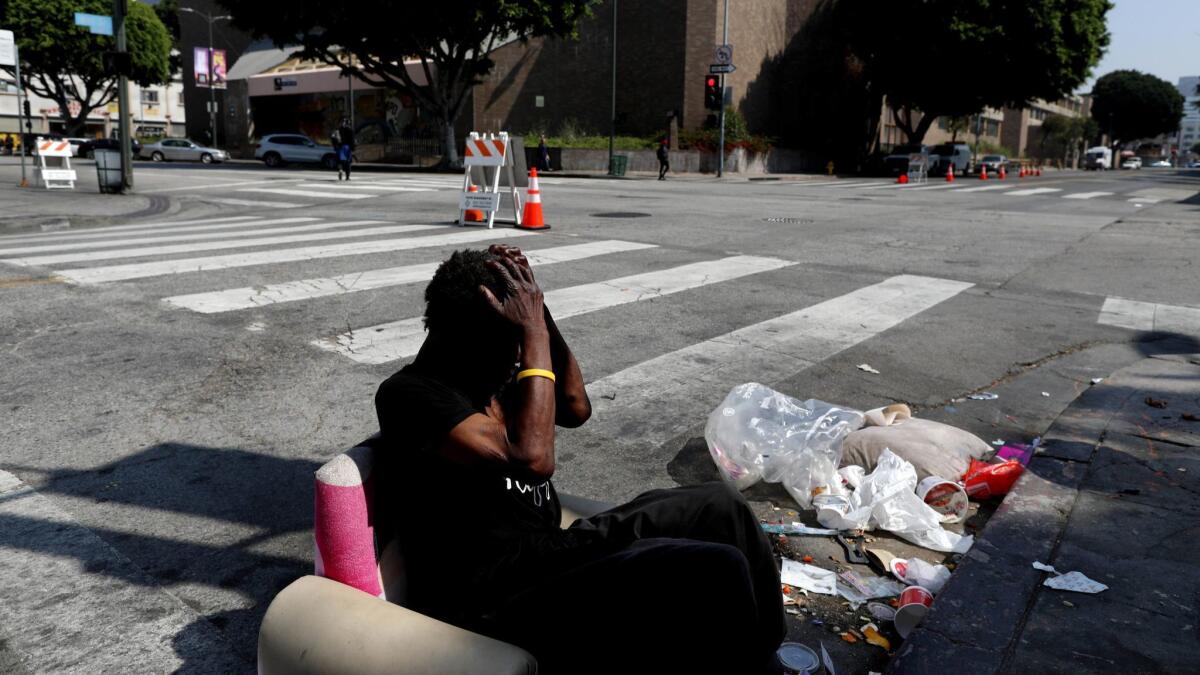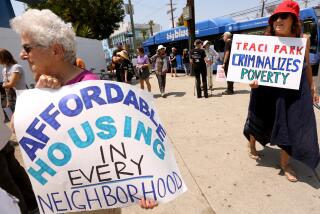Column: Homelessness in L.A. is a catastrophe in motion, and our leaders are largely to blame

- Share via
Some of them are flat broke, some are sick, some work, some have given up hope.
They are homeless in Los Angeles, where mega-mansions and shantytowns share the same ZIP code, and where the dark underbelly of a colossal social breakdown is on full display.
In L.A. city and county, you taxed yourselves to do something about it, and last year alone $619 million was poured into housing and services.
But statistics released Tuesday show that the number of homeless only grew — a 16% increase in the city and a 12% jump in the county — to a staggering total of nearly 60,000 people without homes.
It’s fair to wonder what happened, and how it’s possible to spend all that money only to see the misery multiply and extend deeper into the Westside and the San Fernando and San Gabriel valleys.
RELATED: There’s a trash and rodent nightmare in downtown L.A., with plenty of blame to go around
Have you been ripped off?
More than 20,000 people were brought indoors, so it’s not like we got nothing for our investment. But tens of thousands more spilled onto the streets or took up residence in vehicles, shelters and parks.
There’s a myth that many of them have chosen that life. Some, no doubt, have given up.
But to call homelessness a choice is to dismiss the complexities of human frailty. More common on the streets are tangled narratives of trauma, abuse, loss, physical and mental illness, loneliness, addiction and paralyzing poverty, and yes, some peddle drugs, steal and prey on others to survive.
What we’re looking at now is what happens when city and county officials focus on a festering problem too late, move too slowly, and preside over an evolving catastrophe that may get worse before it gets better, even with thousands more housing units in the pipeline.
The new numbers, which stand as an indictment of the official response, show a 24% increase in the number of homeless young people and a 7% increase among seniors. They underline a direct correlation with the crippling shortage of affordable housing.
And yet several legislative attempts to address the shortage have failed, partly because they involve more density and threaten the status quo for those who live comfortably in single-family homes. You might have expected Gov. Newsom, who made housing a centerpiece of his campaign, to step in, but instead he was a ghost.
When it comes to leadership on the interwoven matters of homelessness and the housing affordability crisis, you do not find too many profiles in courage.
L.A. Mayor Eric Garcetti’s plan for temporary shelters in every neighborhood has been met with neighborhood push-back, and it hasn’t helped that projected costs for those facilities have soared beyond original estimates.
The plan for every council district to build 200-plus units of supportive housing is inexcusably behind schedule.
The process for building housing with voter-approved millions from Measure HHH is maddeningly slow and the cost per unit — as high as $500,000 or more — screams out for a new model.
A few years ago, roughly 100 unused or under-utilized city-owned properties were identified as potential sites for housing. Only about a dozen of them made it to the planning stage, and none of them have been developed.
Even the little things that could make a difference get bollixed up by bureaucracy and lack of political and moral will. To cite one example, the nonprofit Chrysalis has a program to help clean city streets with formerly homeless people, offering them a path toward better lives. And as we all know, Los Angeles has been trashed, partly because of the spread of encampments, partly because of illegal dumping, partly because the city can’t keep up with desperate calls for help.
But a proposal to put 30 more Chrysalis cadets to work helping the city deal with a 311 service call backlog got derailed because the city moved too slowly to take advantage of available funds, and because of union opposition to contracting out such jobs.
When you have an emergency, a moral and humanitarian crisis, as Garcetti called it a year ago, you find ways to make good ideas work rather than invent ways to sabotage them. You build consensus, you lead, you appeal to the mutual interests of both the comfortable and the afflicted.
Garcetti and City Council President Herb Wesson have been in elective office for far too long to get a pass on any of this, and let’s not let county supervisors off the hook, either.
The one concession I’ll make to local officials is that homelessness is a symptom of a far bigger problem than any city or county official can fix without help.
The news of a robust, booming economy is a fabrication. When nearly a quarter of the students at an elementary school are homeless in Pacoima, a community once surrounded by blue-collar jobs that no longer exist, it speaks to the failures of a job market that works extremely well for a few while pushing so many others deeper into the hole.
That’s true to a lesser degree across the country, as well, where economic hardship and homelessness have grown. The spray-painted con man claimed to have a pocket full of easy answers — the return of manufacturing, cheaper and better healthcare for all, a national infrastructure work program, the rebuilding of the inner city. Not only has he whiffed on all of that, but this blubbering blimp of petulant self-parody is putting a squeeze on housing, environmental safeguards and other social programs to pump up defense spending and tax cuts that have mostly benefited his billionaire pals.
California’s wealth, in a way, is driving its poverty. The coastal city empires of commerce can’t function without the support of those who teach our children, take our blood pressure, deliver our mail and fix our cars, but those hard-working folks are barely hanging on in this housing market while tech execs count bonuses and drive the cost of shacks into the millions.
One-third of the county’s residents are paying half or more of their household income on rent as the distance between an apartment and a tent continues to narrow. And we can’t pass a housing bill or deliver more protection to renters?
In 2005, when I first began wandering homeless encampments, I never dreamed we’d be where we are today. The alarms were sounded back then, politicians were shamed into action, strategies were unveiled, promises of an end to homelessness were made by those in power, and then the focus faded into the dust of the great crash.
Back then, I wrote a column about a skid row corner where homeless prostitutes worked in port-a-potties — one of them lived in one of them — and rats scurried about. This was the headline:
“A corner where L.A. hits rock bottom.”
I spoke too soon. The rats have now been found a block away.
In the police station.
And the words “typhus” and “typhoid” have been dredged up from the Dark Ages.
Back then, I wrote about a musician with a deep talent and an even deeper mental illness. He suffered the daily torments so many thousands of homeless people still suffer. One night, as he prepared to sleep on the pavement, he reached for two sticks. On one he had written “Beethoven,” on the other, “Brahms.” When the rats came out of the sewers, he told me, he tapped Beethoven and Brahms, and the rats scattered.
Now we have rats at City Hall and new evidence of a connection to several nearby homeless encampments.
It’s naive of me, I know, but I’d like to believe that the disturbing new numbers will drive a greater sense of urgency, that the governor and legislators and local officials will move faster and more creatively, that more residents will step up rather than stand in the way, that we might one day have a president with a heart and a brain or even just a clue.
We should, here in a place where 60,000 human beings have fallen through the cracks, be compassionate and angry enough to demand nothing less.
Get more of Steve Lopez’s work and follow him on Twitter @LATstevelopez
More to Read
Sign up for Essential California
The most important California stories and recommendations in your inbox every morning.
You may occasionally receive promotional content from the Los Angeles Times.











